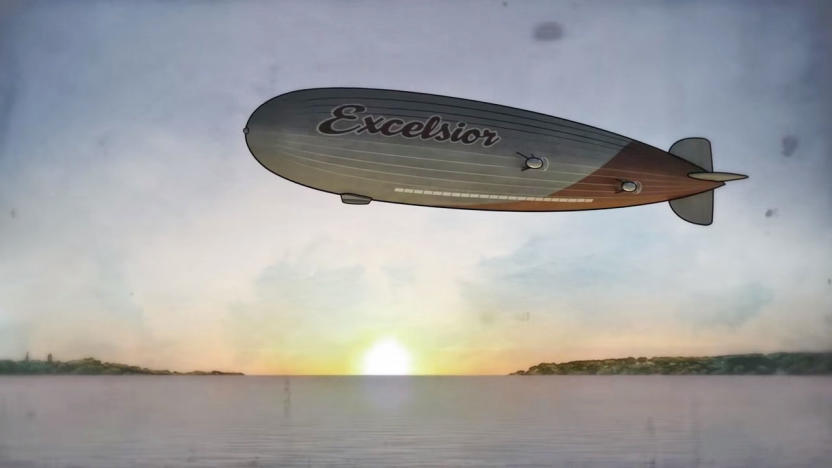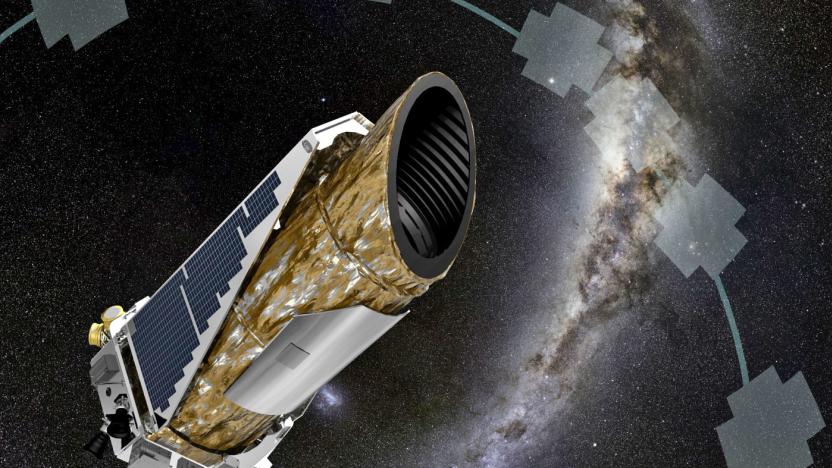AmesResearchCenter
Latest

Bloomberg: Google co-founder Sergey Brin has a 'secret airship'
A couple of days ago we got a good look at a "flying car" backed by Google's Larry Page, and now Bloomberg reports that Sergey Brin has a project too -- it's a zeppelin. The airship "which isn't an Alphabet project" is being built in a leased hangar at the NASA Ames Research Center, although it's unclear if there are any plans to make a business out of it. The report points to former NASA director Alan Weston as leader of the project, citing a radio interview where he described a helium-filled (it's actually flame-retardant) vehicle for cargo hauling and a LinkedIn profile that momentarily listed him as CEO of "Ltare."

NASA's Kepler spacecraft is in 'emergency mode'
NASA's Kepler space telescope was supposed to be continuing its K2 extended mission to hunt down hidden exoplanets, but now scientists say the spacecraft is in trouble (again). While trying to make regularly scheduled contact on Thursday engineers found that it is operating in "emergency mode" and are focused on trying to recover it. That's a bit tricky however, since it's almost 75 million miles away from Earth, and it takes 13 minutes for signals to make a round trip.

NASA to test sugary bacteria as space-based power source
Following its successful harvest of red leaf lettuce, NASA has announced plans to launch genetically engineered bacteria into orbit to see if they can be harnessed by future astronauts as potent survival resource. The experiment is scheduled to take place in 2017 and will study the genus Anabaena. The sugars that these cyanobacterium photosynthesize can be fed to other genetically-modified bacteria in a system the agency calls PowerCell. These second-stage bacteria would, in turn, generate chemicals, food, fuel and even medicine for far-flung astronauts. "The first pilgrims who came to the Americas didn't bring all their food for the rest of their lives," Lynn Rothschild of NASA's Ames Research Center, said in a statement. "You need to live off the land."

NASA and Nissan team up to on self-driving cars and space rovers
NASA and Nissan believe they've got a lot to learn from each other when it comes to autonomous vehicle technology. So, the two have decided to team up for the next five years and develop a self-driving system that they can use not just on Earth, but also in space. A team of scientists from both organizations will design an autonomous vehicle technology at the NASA Ames Research Center, home to Moffett Field, where Google is also testing its self-driving auto prototypes. The duo will start by conjuring up a fleet of zero-emission robotic cars, presumably modified Nissan Leafs, as that's exactly what's pictured above. They expect to start test driving the first one by the end of 2015.

Google and NASA team up for D-Wave-powered Quantum Artificial Intelligence Lab
Google. NASA. Quantum computers. Seriously, everything about the new Quantum Artificial Intelligence Lab at the Ames Research Center is exciting. The joint effort between Mountain View and America's space agency will put a 512 qubit machine from D-Wave at the disposal of researchers from around the globe, with the USRA (Universities Space Research Association) inviting teams of scientists and engineers to share time on the unique super computer. The goal is to study how quantum computing might be leveraged to advance machine learning, a branch of AI that has proven crucial to Google's success. The internet giant has already done some work with quantum computing before, now the goal is to see if its experimentation can translate into real world results. The idea, for Google at least, is to combine the extreme (but highly-specialized) power of the quantum bit with its oceans of traditional data centers to build more accurate models for everything from speech recognition to web search. And maybe, just maybe, with the help of quantum computers your phone will finally realize you didn't mean to say "duck."

Vizualized: Bay Area bids adieu to Space Shuttle Endeavour (update: video)
NASA and the US government may have moved on from the shuttle program, but it's clear that the American people are still in love with our nation's cosmic cargo planes. An estimated 20,000 people showed up at the Ames Research Center/Moffet Air Force Base in Mountain View, California this morning to see Endeavour buzz the tower. With so many folks itchin' to see Endeavour's farewell tour firsthand, the line to get in was lengthy, but we braved the crowds to bring you some shots of the action. Enjoy. [Thanks to Chris Williams for helping with some of the crowd shots] Update: Canon/RED guru and LA-based DP Vincent Laforet caught the shuttle's final approach and landing at LAX. You'll find the slow-motion clip, shot at 5K resolution on a RED Epic at 96 frames-per-second with an 800mm Canon f/5.6 lens, just past the break.

ArduSat wants to put Arduino satellite, your experiments into orbit
Short of scoring a spot on the ISS experiment docket, putting your scientific aspirations into orbit can be a bit tricky. Why not try crowdsourcing your way into space? ArduSat's barking up that very tree, asking Kickstarter contributors to help them get a Arduino CubeSat off the ground. Headed by NanoSatisfi, a tech startup operating out of NASA's Ames Research Center, the project hopes to raise enough funds to launch an Arduino bank and a bevy of open-source sensors into orbit. The payoff for backers? Access. Varying levels of contribution are rewarded with personalized space broadcasts, remote access to the space hardware's onboard cameras and even use of the machine's sensors to run experiments of the backer's own design. If all goes well, the team hopes to launch more satellites for the everyman, including a unit dedicated to letting would-be stellar photographers take celestial snapshots. Sure, it's far cry from actually launching yourself into the stars, but would you rather be a tourist, or a scientist? Check out project at the source link below, and mull over that for awhile.

NASA's shuttle PCs sold with sensitive data intact, insert WikiLeaks joke here
Let this be a warning for John and Jane Q. Public (always a cute couple, those two) to always wipe sensitive / secret data from your hard drives before selling a computer. Or better yet, take out the drive entirely and physically destroy it. That's what we'd expect from our government entities, but an internal investigation found that a number of PCs and components from NASA's shuttles had been sold from four different centers -- Kennedy and Johnson Space Centers, and Ames and Langley Research Centers -- that "failed sanitization verification testing," or weren't even tested at all. In Langley's case, while hard drives were being destroyed, "personnel did not properly account for or track the removed hard drives during the destruction process." Meanwhile at Kennedy, computers were found being prepped for sale that still had "Internet Protocol information [that] was prominently displayed." Helluva way to start a shuttle launch retirement, eh?

NASA turns iPhone into chemical sensor, can an App Store rejection be far away?
People have been trying to turn cellphones into medical and atmospheric scanners for some time now, but when it's NASA stepping up to the plate with a little device to monitor trace amounts of chemicals in the air, it's hard to not start thinking we might finally have a use for all those tricorder ringtones. Developed by a team of researchers at the Ames Research Center led by Jing Li, the device is a small chip that plugs into the bottom of an iPhone and uses 16 nanosensors to detect the concentration of gasses like ammonia, chlorine, and methane. To what purpose exactly this device will serve and why the relatively closed iPhone was chosen as a development platform are mysteries we're simply not capable of answering. Damn it, man, we're bloggers not scientists! Update: George Yu, a developer who wrote this implementation for Jing Li, commented to let us know that the choice to go with the iPhone was made because it was "cool," but he soon realized that choice was a "horrible mistake." We're guessing that could have something to do with an apparent lack of wireless coverage at Ames if the above screenshot is anything to go by.






